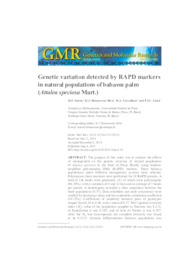Genetic variation detected by RAPD markers in natural populations of babassu palm (Attalea speciosa Mart.).
Genetic variation detected by RAPD markers in natural populations of babassu palm (Attalea speciosa Mart.).
Author(s): SILVA, K. J. D. e; CARVALHAES, M. A.; LIMA, P. S. da C.
Summary: The purpose of this study was to analyze the effects of management on the genetic structure of natural populations of Attalea speciosa in the State of Piauí, Brazil, using random-amplified polymorphic DNA (RAPD) markers. Three babassu populations under different management systems were selected. Polymerase chain reactions were performed for 20 RAPD primers. A total of 146 bands were generated, 141 of which were polymorphic (96.58%), with a variation of 4 and 12 loci and an average of 7 bands per primer. A dendrogram revealed a clear separation between the three populations (0.57). Data reliability and node consistency were verified by bootstrap values and the cophenetic correlation coefficient (88.15%). Coefficients of similarity between pairs of genotypes ranged from 0.26 to 0.86, with a mean of 0.57. Nei?s genetic diversity index (HE) value of the population sampled in Teresina was 0.212, of Esperantina it was 0.195, and of José de Freitas it was 0.207. After the HE was decomposed, the complete diversity was found to be 0.3213. Genetic differentiation between populations was0.362, and the estimation of gene flow between populations was low (0.879). Analysis of molecular variance revealed that 59.52% of the variation was contained within populations, and 40.48% was between populations. RAPD markers were effective for genetic diversity analysis within and between natural babassu populations, and exhibited a high level of polymorphism. Genetic diversity was the highest within populations; variability was lower in the managed populations than in the undisturbed populations.
Publication year: 2015
Types of publication: Journal article
Unit: Embrapa Mid-North
Observation
Some of Embrapa's publications are published as ePub files. To read them, use or download one of the following free software options to your computer or mobile device. Android: Google Play Books; IOS: iBooks; Windows and Linux: Calibre.
Access other publications
Access the Agricultural Research Database (BDPA) to consult Embrapa's full library collection and records.
Visit Embrapa Bookstore to purchase books and other publications sold by Embrapa.

